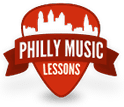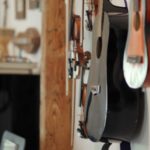
Want to Become a Jazz Guitarist? Listen
I get a lot of new students that are interested in learning jazz guitar. Across the board, my first piece of advice to them is almost always the same: listen to jazz. This seems almost so obvious that it need not be stated. One would assume that if you’ve gone as far as to sign up for jazz guitar lessons, you’re probably already checking out some jazz. Yet I still stress its importance to nearly every new student I get. There’s a common misconception that learning jazz guitar means sitting down and working out all of your modes of the major scale, learning the difference between a 13(b9) chord and a 9(b13) chord, and practicing all of your drop-2 voicings on every string group. And it’s true, you need all of that to thoroughly learn this style. But all of that, to me, accounts for maybe 10% of what it really takes to learn to play jazz. The other 90% is listening.
Jazz musicians often talk about the “language” of jazz, treating the constructs and common practices of the music as a musical dialect. Thinking of the music in this way certainly speaks to the importance of listening. Imagine a scenario in which an American student wants to learn how to speak German, so they buy a German textbook, and they learn all of the impossibly convoluted sentence structures. They memorize vocabulary lists, and they work on translating English sentences into German. But the one thing they neglect is listening to fluent speakers speaking German. They would certainly know a lot about the German language, but they wouldn’t be able to speak it at all. Jazz is no different. You can go through every theory book in the world, learn all of your chord voicings, and practice all of your modes, and still sound like you have no idea what you’re doing when you play a tune. Listening is the key to applying the theory. The last thing I would want my new student to do, after I give them my spiel on listening, is go home and force themselves to sit through ten jazz records, not enjoying a single one. The key is finding jazz that you love. And I don’t just mean that you listen to it and think, “that was cool,” and then move on. You should find something that makes you reach for the repeat button as soon as it ends, because you can’t wait to hear it again. It should become the first thing you search for when you open Spotify on your phone, and the last thing you listen to before you go to bed.
With jazz having been around for over a hundred years, finding records like this can prove somewhat complicated. The good news is, the diversity that exists under the umbrella of this genre is extraordinary, so there is definitely something there for everyone. The bad news is, the sheer volume of records can make it pretty hard to find exactly what that is for you. As a jazz guitar teacher, this is my true role: not as a theory teacher, or a guitar teacher, but rather as a guide for my students through the veritable sea of recordings, leading them towards falling in love with the music, just as I did years ago. All that’s left, then, is to explain what’s going on.
Essential Jazz Guitar Recordings
This is a compilation of recordings Charlie Christian made with clarinetist Benny Goodman. Charlie Christian was pretty much the first important electric guitar player, establishing the guitar as more than just a rhythm instrument. His single-line improvisation style influenced countless guitar players after him. Check out his solo on “Rose Room,” it set the standard for electric guitar playing.
Wes Montgomery might be the most important jazz guitarist of all time. This 1965 recording features Wynton Kelly on piano, Paul Chambers on bass, and Jimmy Cobb on drums (this rhythm section first played in Miles Davis Quintet in 1960 with John Coltrane). Wes is on fire throughout this recording, especially on “If You Could See Me Now,” which I consider to be one of the most perfectly constructed solos of all time. You can also hear his signature 3-part solo style, starting with single lines, then moving to octaves, then finishing with chord soloing, on “Unit 7.” Also listen to the way he “riffs” (plays a repeated phrase) to engage the rhythm section throughout his solo on “No Blues.” All in all, a masterclass of sound, feel, and development.
Around the same time that Wes Montgomery was making records, Grant Green was the other giant of jazz guitar (they were mutual admirers of each other, and Wes was known to travel to Detroit just to see Grant Green play). Organist Larry Young is the leader on this 1964 recording, but Green really shines as a sideman. Sam Rivers plays tenor saxophone and Elvin Jones is on drums, with 5 Larry Young compositions providing the material. Green’s solo on the 12 bar blues “Backup” is a highlight; note his laid-back feel and the way he uses repeated phrases to build his solo.
Guitar players aren’t often used in place of a piano player, but Sonny Rollins did just that on this 1962 recording. Jim Hall plays some beautiful solos on this recording, but more importantly, he accompanies Rollins masterfully. Pay attention to his comping on “Without a Song,” the way he mixes single lines and chords to fill out the rhythm section without over-playing. Bob Cranshaw plays bass and Ben Riley plays drums.
After the death of Wes Montgomery in 1968, George Benson emerged as the foremost jazz guitarist of his generation. He is probably more well-known for his soul/R&B recordings of the mid-1970s, but he began his career as a jazz guitarist in the organ bands of Jack McDuff and Dr. Lonnie Smith. This 1966 recording, Benson’s second as a leader, features an organ band with Dr. Lonnie Smith (organ), Ronnie Cuber (baritone saxophone), Bennie Green (trombone), Albert Winston (electric bass), and Jimmy Lovelace or Marion Booker, Jr. on drums. Listen to Benson’s solo on “The Cooker” and pay attention to his picking style – his articulation is incredibly clear and swinging. 6. Kenny Garrett (with Pat Metheny on guitar) – Pursuance
This record is a tribute to John Coltrane, featuring 11 of his compositions. Like The Bridge, this is a quartet record with guitar instead of piano, so you get to hear Pat Metheny’s comping as well as his soloing. He shines at both. This isn’t going to give you a complete picture of Metheny the musician (for that you need to hear Bright Size Life and his work with Lyle Mays), but to hear Metheny the guitarist there isn’t a better record in my opinion. Highlights include his sensitive and melodic solo on Dear Lord and his acoustic playing on After the Rain. Features Rodney Whitaker on Bass, Kenny Garrett on alto saxophone and Brian Blade on drums.
Kurt Rosenwinkel is the most important jazz guitarist to emerge in the last 30 years. His music didn’t just change guitar playing, it helped define the sound of jazz in the 1990s and influenced pretty much every jazz guitarist after him. Deep Song captures the sound of Kurt’s style perfectly – it features mostly his original compositions, with imaginative arrangements of two standards as well. The band is an all-star quintet – Josh Redman on tenor saxophone, Brad Mehldau on piano, Larry Grenadier on bass, and either Jeff Ballard or Ali Jackson on drums. Kurt combines shredding guitar playing with soulfulness on every track – Cake and The Next Step are highlights.
This is the album I would recommend to a metalhead looking to get into jazz. If you want to hear the most intense, crazy, distorted jazz guitar playing ever, this is the record. Sonny Sharrock’s playing complements Pharaoh Sanders’ screaming saxophone sound perfectly, and the rhythm section of Elvin Jones and Charnett Moffett on drums and bass
brings a ton of intensity and swing. This is an exciting record that’s not for the faint of heart.
Around the same time Kurt Rosenwinkel appeared on the scene, so did Peter Bernstein, touring with artists such as Sonny Rollins and Jimmy Cobb. In my opinion, this record set a new standard for solo guitar playing. Peter’s rhythmic feel is perfect, and the intricacy of his chordal work can’t be overstated. “Django” tells you all you need to know about this modern guitar master.
This is a very different kind of solo guitar record from Peter Bernstein’s, but just as essential. Ted Greene only ever put out one record, and this is it. His sound (he plays a telecaster!) is so warm, and the movement of notes within his chords and the independence of the lines is unbelievable. Listen to Danny Boy and wonder how anyone could possibly play the guitar that way.
Elijah Cole
I started playing the piano at age 5, and added the guitar at age 12. By 15, I was performing professionally on both instruments. By the time I finished high school, I was not only performing regularly around the DC area, I was also teaching around 10 students per week on piano, guitar, ukulele, and electric bass. I perform often in the Philadelphia area, and travel regularly to DC to perform there as well. My goal as a teacher is to develop in my students the same love for music that I have felt since first taking up piano at age 5. My mission as a performer is to create music that stimulates the mind, soul, and spirit of its listeners.


